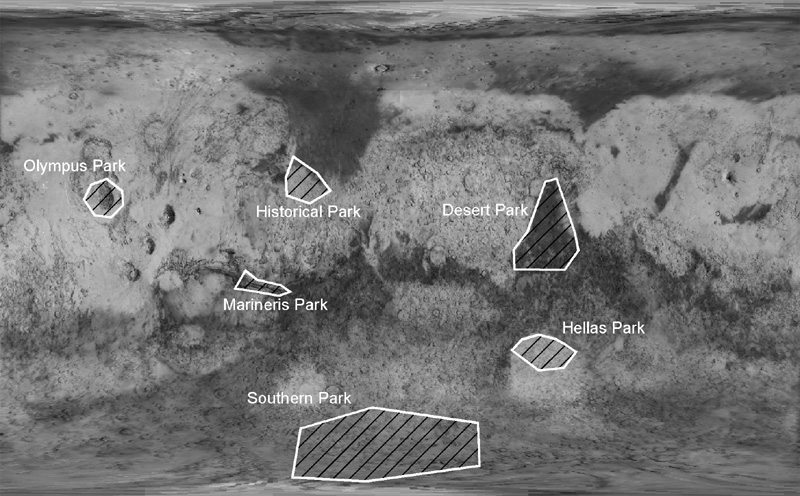
This map of Mars (© Charles Cockell) highlights six of the proposed conservation sites – the Polar Park is not shown.

A few weeks later a North American team; Dr. Joseph Resnick, Dr. Timothy R. O'Neill and Guy Cramer (ROC-Resnick/O'Neill/Cramer team) following the idea as put forth by the two European scientists started the process of turning these regions into parks by obtaining the mineral rights to these regions to protect them from the commercialization expected to one day encroach on these Martian lands. Dr. Resnick (former NASA scientist and current consultant to NASA) states "Space law do not allow countries to have land ownership on planets and moons in the solar system but it does allow for the Mineral Rights to be obtained by individuals and companies." Dr. Resnick was structuring the Universal Mineral Leases Registry (UMLR) when his partner, Guy Cramer, had read the article on the Mars parks proposal and discussed the ability with Dr. Resnick and Dr. O'Neill to implement the idea into reality through the UMLR. The ROC team agreed and decided to obtain the mineral rights to these regions, to set them aside as protected areas, prior to the public launch of the UMLR.
The 1979 Moon Agreement specifically seeks to regulate the exploration and exploitation of natural resources found on the Moon and other celestial bodies; the U.S., Russia, China and many other countries have not ratified this agreement.
The North American team issued this statement "We support the effort to protect these Martian areas and by virtue of 'owership' via the Universal Mineral Leases Registry (UMLR), we are designating the areas as "preserves". This effort constitutes the first-of-a-kind "Extraterrestrial Nature Preserve" established by human beings and sanctioned by the owners of the mineral rights located in the Mars regions. Furthermore we have obtained the mineral rights for a large Lunar area surrounding the Apollo 11 landing site and designated this area as a "World Heritage Site" which will allow our future space fairing decedents the opportunity to see this site as it remains on the timeless lunar soil of our first astronauts landing on another celestial body".
This Registry www.universalmineralleasesregistry.com is filed with the U.S. Patent and Trademark Office and updated semi-annually.
The North American team actually obtained areas on Mars larger (shown below) than those proposed by the two Europeans and included both the Martian North and South Polar regions;
Olympus Mons rises 23 km (~75,000 ft) above the surrounding plains and is
the highest known peak in the Solar System. The altitude of Olympus Mons
is three times the altitude of the largest peak on Earth, Mt. Everest, and is as
wide as the entire chain of Hawaiian Islands. The distance from one end of where
the mountain starts rising to the other side is over 372 miles (600 kilometers).
This is farther than the distance from Chicago, Illinois to Minneapolis,
Minnesota. So if you think of Olympus Mons as taking up more space than the
state of Wisconsin, you will have a good idea of just how much of the surface of
Mars this giant mountain covers.
| 141.1°W | 124.9°W | ||
|---|---|---|---|
| 26.5°N | 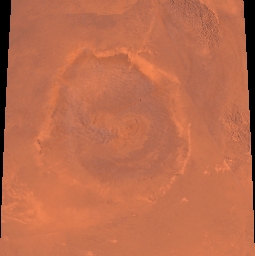 |
26.5°N | |
| 10.5°N | 10.5°N | ||
| 141.1°W | 124.9°W | ||
Image size = 256 rows by 255 columns.
Resolution = 16.0000 pixels per degree (true at the equator).
Scale = 3.7016 kilometers per pixel (true at the equator).
| 101.5°W | 19.5°W | ||
|---|---|---|---|
| 4.0°N |
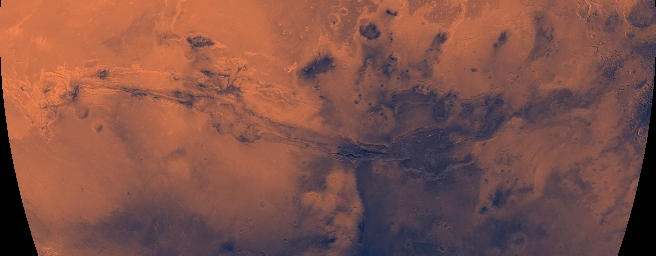 |
4.0°N | |
| 28.0°S | 28.0°S | ||
| 101.5°W | 19.5°W | ||
Image size = 256 rows by 656 columns.
Resolution = 8.0000 pixels per degree (true at the equator).
Scale = 7.4033 kilometers per pixel (true at the equator).
| 58.0°W | 33.0°W | ||
|---|---|---|---|
| 30.0°N |
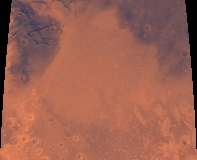 |
30.0°N | |
| 10.0°N | 10.0°N | ||
| 58.0°W | 33.0°W | ||
Image size = 160 rows by 197 columns.
Resolution = 8.0000 pixels per degree (true at the equator).
Scale = 7.4033 kilometers per pixel (true at the equator).
The large, dark, "shark's fin"-like feature which dominates this face of Mars is called Syrtis Major Planitia. Syrtis Major Planum, is a low-relief volcanic shield of probable basaltic composition. This was the first feature identified on the surface of the planet by early terrestrial observers in the Seventeenth Century. It was used by Christian Huygens to measure the rotation rate of Mars - a martian day is about 24 hours and 37 minutes.
| -46.0°W | -84.0°W | ||
|---|---|---|---|
| 29.0°N |
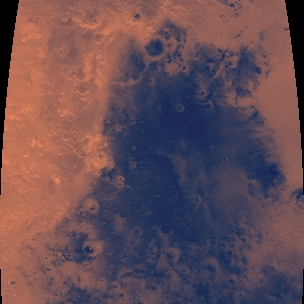 |
29.0°N | |
| 9.0°S | 9.0°S | ||
| -46.0°W | -84.0°W | ||
Image Statistics:
Image size = 304 rows by 304 columns.
Resolution = 8.0000 pixels per degree (true at the equator).
Scale = 7.4033 kilometers per pixel (true at the equator).
| -44.5°W | -84.5°W | ||
|---|---|---|---|
| 25.5°S |
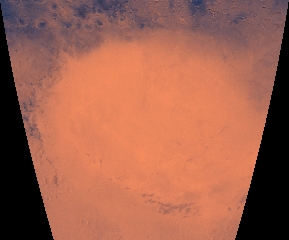 |
25.5°S | |
| 55.5°S | 55.5°S | ||
| -44.5°W | -84.5°W | ||
Image size = 240 rows by 289 columns.
Resolution = 8.0000 pixels per degree (true at the equator).
Scale = 7.4033 kilometers per pixel (true at the equator).
| 50.2°W | -24.2°W | ||
|---|---|---|---|
| 50.5°S |
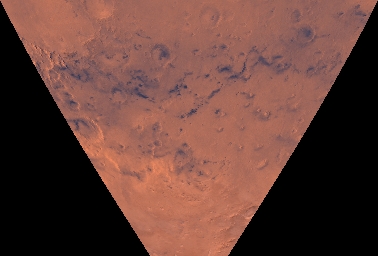 |
50.5°S | |
| 82.5°S | 82.5°S | ||
| 50.2°W | -24.2°W | ||
Image Statistics:
Image size = 256 rows by 378 columns.
Resolution = 8.0000 pixels per degree (true at the equator).
Scale = 7.4033 kilometers per pixel (true at the equator).
| 50.3°W | -50.3°W | ||
|---|---|---|---|
| 90.0°N |
|
90.0°N | |
| 83.0°N | 83.0°N | ||
| 50.3°W | -50.3°W | ||
Image size = 28 rows by 49 columns.
Resolution = 4.0000 pixels per degree (true at the equator).
Scale = 14.8065 kilometers per pixel (true at the equator).
| 50.3°W | -50.3°W | ||
|---|---|---|---|
| 84.0°S |
|
84.0°S | |
| 90.0°S | 90.0°S | ||
| 50.3°W | -50.3°W | ||
Image Statistics:
Image size = 24 rows by 42 columns.
Resolution = 4.0000 pixels per degree (true at the equator).
Scale = 14.8065 kilometers per pixel (true at the equator).

World Heritage Site
| 21.1°E | 25.8°E | ||
|---|---|---|---|
| 2.7°N |
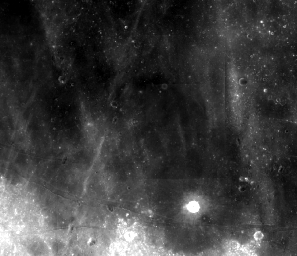 |
2.7°N | |
| 1.3°S | 1.3°S | ||
| 21.1°E | 25.8°E | ||
Image size = 256 rows by 297 columns.
Resolution = 64.0000 pixels per degree (true at the equator).
Scale = 0.4738 kilometers per pixel (true at the equator).
The ROC Team has acquired a few other sites of interest on Mars and the Moon through the UMLR that are of Scientific interest, but they have not designated those areas for protection from mineral acquisition or mining. Consideration will been given by the team to allowing countries open access to most of those areas for selections of landing sites to optimize the science return and benefit for exploration.
On January 14, 2004 U.S. President Bush announced a new vision for NASA that incorporated a human return to the Moon by 2020, follow-on exploration of Mars and other destinations.
A recent meeting of some 200 scientists from 17 countries expects "lunar landers cooperating into an international lunar robotic village before 2014", evolving technologies for human-tended missions that prepare the ground for an "effective, affordable human lunar exploration and permanent presence by 2024."
The ROC team is expected to work with NASA's Moon-Mars and Beyond Initiative and International Space Agencies to set aside specific regions of interest for potential; landing, launch, habitat, exploration, environmental, communication, experimentation, industrialization and commercialization sites
With key areas now obtained and protected by the ROC team, the public now has access of the www.universalmineralleasesregistry.com for acquisition of mineral rights to other areas on the Moon, Mars and Beyond.
This is Part 1 of 3 Go to Part 2
References:
http://www.nature.com/news/2004/041122/full/041122-15.html#B2
http://www.space.com/news/international_moon_041201.html
http://www.windows.ucar.edu/tour/link=/mars/interior/Martian_volcanos.html
http://www.adlerplanetarium.org/learn/planets/mars/olympusmons.ssi
http://www.adlerplanetarium.org/learn/planets/mars/vallesmarineris.ssi
http://www.adlerplanetarium.org/learn/planets/mars/chryseplanitia.ssi
http://hubblesite.org/newscenter/newsdesk/archive/releases/1991/05/image/a
http://shop.store.yahoo.com/spaceimages/symahe.html
http://www.adlerplanetarium.org/learn/planets/mars/hellasplanitia.ssi
http://www.adlerplanetarium.org/learn/planets/mars/planumboreum.ssi
http://www.adlerplanetarium.org/learn/planets/mars/highlands_lowlands.ssi
http://www.adlerplanetarium.org/learn/planets/mars/planumaustrale.ssi
www.universalmineralleasesregistry.com
This material is Copyright © 2004 by Joe Resnick, Timothy R.
O'Neill and Guy Cramer, All Rights Reserved.
This material cannot be reproduced in any form without the expressed written
permission of the Author. Whole Copies may be printed for personal use; no
changes are to be made to the content, names or references.